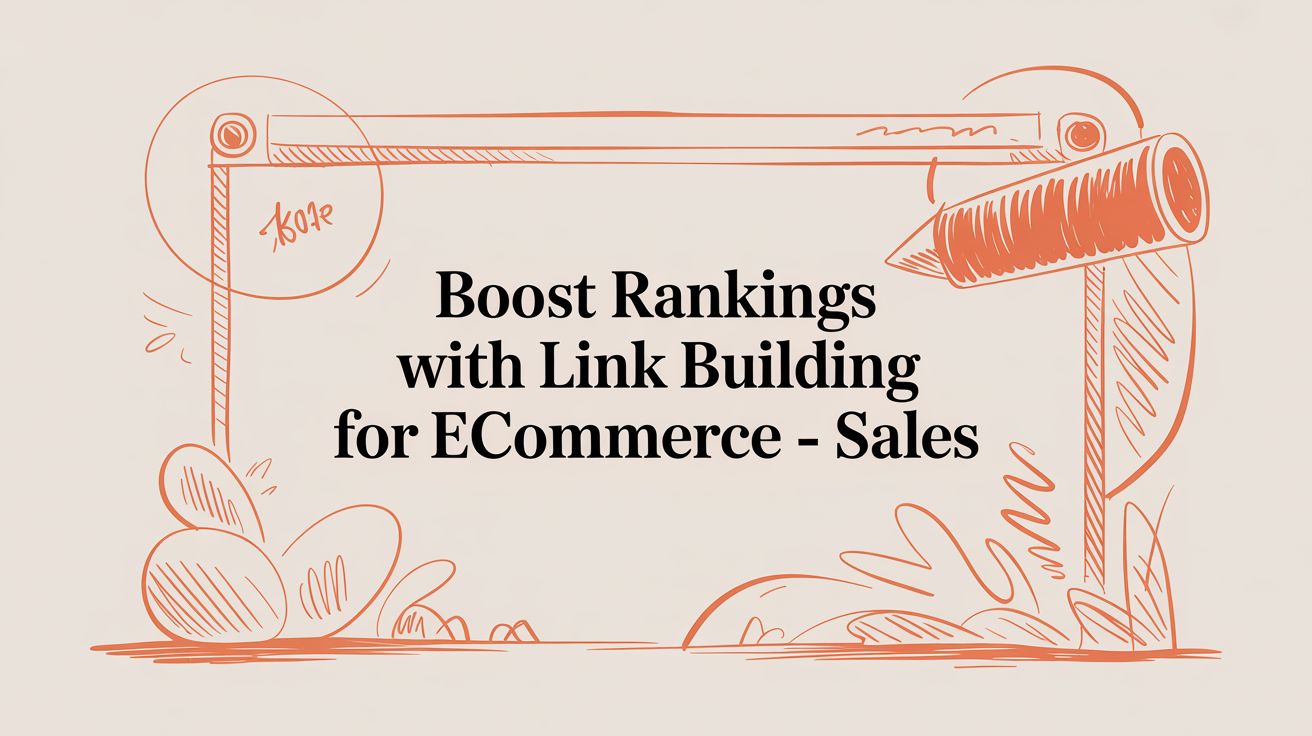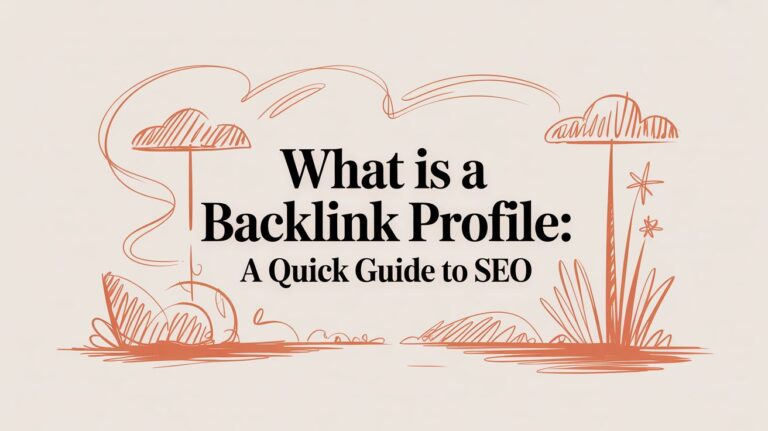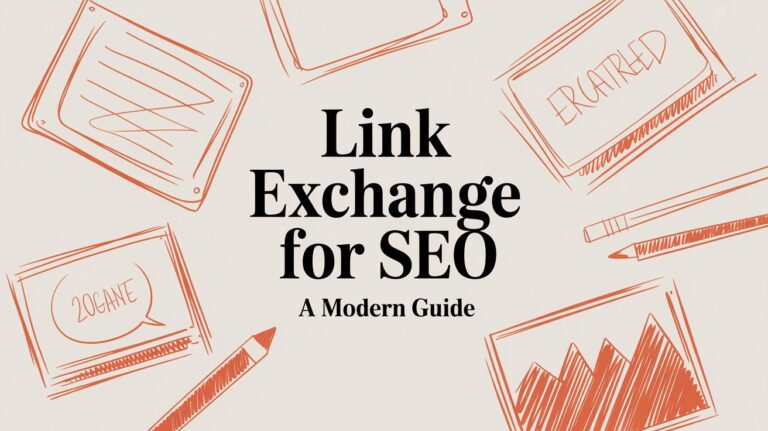Boost Your Sales with Link Building for Ecommerce
An earned link from a reputable website is more than a technical SEO win; it's a powerful endorsement for your online store. This process, known as link building for ecommerce, signals to search engines that your site is a credible authority. Get it right, and you'll see a direct impact on your rankings, traffic, and sales.
Why Backlinks Are Crucial for Ecommerce Growth

Let's be clear: building links for an ecommerce site is challenging. Your product pages aren't the type of content that naturally attracts links. However, a smart backlink strategy is a fundamental pillar for growth, not just another SEO task.
Think of each backlink as a vote of confidence. When a high-authority site links to you, it tells Google, "Hey, these guys are legit." This digital endorsement is one of the most powerful ranking signals.
This isn't just theory. 92% of SEO professionals believe backlinks will remain a major ranking factor for the next five years. With 68% of online experiences starting on a search engine, you can't afford to ignore it. You can read more on the value of link building from Yotpo.
To help, here’s a breakdown of a well-rounded ecommerce link building strategy.
Core Components of a Successful Ecommerce Link Building Strategy
This table outlines the foundational pillars of an effective link building campaign for ecommerce businesses.
| Component | Objective | Key Actions |
|---|---|---|
| Asset Identification | Find pages that can earn links and drive revenue. | Analyze keyword data, competitor backlinks, and sales metrics to identify high-value pages. |
| Content Creation | Develop link-worthy content that attracts attention. | Create gift guides, tutorials, data-driven studies, and resource hubs that solve problems. |
| Strategic Outreach | Build relationships with journalists, bloggers, and influencers. | Personalize email pitches, offer unique value (like data or quotes), and follow up. |
| Technical SEO | Ensure your site's health supports link building. | Fix broken links, use canonical tags, optimize internal linking, and ensure your site is crawlable. |
| Partnerships | Collaborate with complementary brands to build links. | Co-create content, run joint giveaways, or be a guest expert on a partner's blog or podcast. |
Each component is vital. A successful campaign combines smart content, technical precision, and genuine relationship-building.
The Real-World Impact of a Strong Backlink Profile
Quality backlinks deliver tangible business results that boost your bottom line. They create a powerful, self-sustaining growth engine.
A well-executed link building campaign will:
- Build Lasting Brand Authority: When industry sites and influencers reference your store, you build trust with search engines and customers. Your brand becomes a go-to resource.
- Drive High-Converting Referral Traffic: A link from a popular blog can send a steady stream of ready-to-buy customers. This traffic converts well because it comes from a trusted recommendation.
- Create a Competitive Moat: A robust backlink profile is difficult for competitors to replicate. They can copy your products, but not your network of authoritative links. It’s a sustainable advantage.
The goal of link building isn't just to rank higher. It's to establish your store as a recognized brand that customers trust—the ultimate defense in a crowded market.
Your Roadmap to Building Links That Matter
This guide is your playbook for building a backlink profile that actually moves the needle. We'll skip generic advice and dive into actionable strategies tailored for ecommerce.
We'll cover identifying your most valuable pages, creating compelling content, launching outreach campaigns, and using technical SEO to maximize your efforts. Let's get started.
Finding Your Most Linkable Ecommerce Pages
A common mistake is focusing link building solely on the homepage. It's important, but it rarely attracts the high-quality links that drive traffic and sales. A winning strategy starts by pinpointing your most link-worthy assets—pages so useful that other websites want to link to them.
This is about precision. Stop thinking only about your brand and start thinking about the problems your products solve. The sweet spot is where high business value and high linking potential meet.
Look Beyond Standard Product Pages
Standard product pages are incredibly difficult to build links to. Why would a blogger link to your "Men's Classic T-Shirt" page unless paid? They are transactional and offer little value to an external audience.
The gold is in pages that educate, inform, or solve a problem. These pages are magnets for backlinks because they serve a purpose beyond the sale, establishing your expertise.
The most effective ecommerce link building targets content that answers a question. A coffee retailer will earn more links to its 'Beginner's Guide to French Press' than to its product page for a coffee maker. The guide is a resource; the product page is a sales pitch.
How to Uncover Your Linkable Assets
Finding your best link-building targets requires data and strategic thinking. Your "linkable assets" are often pages that already perform well but could be supercharged with a stronger backlink profile. Start with your own analytics.
Open Google Analytics and look for pages with:
- High Conversion Rates: These pages already turn visitors into customers. Driving more authority to them directly impacts your bottom line.
- Strong User Engagement: Pages with low bounce rates and high time-on-page are hitting the mark. This signals quality content that others will find valuable.
Next, use an SEO tool like Ahrefs or Semrush. Find pages stuck on the second or third page of Google for valuable keywords. These are low-hanging fruit—a few powerful backlinks could push them to page one.
Prioritizing Your Targets
Once you have a list of potential pages, prioritize them. Focus on content types that consistently attract links.
Here’s where I’d start:
- High-Margin Category Pages: Building links to top-level category pages for profitable products can lift the rankings for every product in that category.
- In-Depth Buying Guides: A guide like "The Ultimate Guide to Choosing a Laptop for College" is an evergreen asset that solves a real problem and attracts links from forums, tech blogs, and university sites.
- Unique Resource Pages: Offer unique value, like interactive calculators or a detailed glossary. For inspiration, check out these excellent examples of what a powerful resource page looks like and see how they can apply to your store.
By carefully identifying and prioritizing these pages, you ensure every backlink delivers maximum impact, turning link building into a predictable driver of traffic and sales.
Creating Content That Actually Earns Ecommerce Links
Let's be honest: your product and category pages are designed to sell, not attract links. And that's fine. To build authority and drive organic traffic, you need a different approach. You must create content that journalists, bloggers, and experts want to link to.
This means building informational assets, not just transactional pages. Create link magnets—content so good it establishes your store as an authority. Move beyond standard blog posts and develop resources that solve real problems, turning your site into a go-to hub.
A Blueprint for Link-Worthy Ecommerce Content
Instead of guessing, use a repeatable process. Successful e-commerce stores focus on proven formats that appeal to link-giving sources.
Three content types consistently outperform others for e-commerce:
- Comprehensive Resource Hubs: These deep-dive pages cover a topic from every angle, making them an easy and valuable resource to link to.
- Niche Gift Guides: Bloggers and journalists always need unique gift ideas. A specific, well-executed gift guide can be a quick win for landing high-authority links.
- Data-Driven Reports: Using your internal data to create a unique study is one of the most powerful ways to get top-tier media links. It's original, proprietary, and highly citable.
Crafting Comprehensive Resource Hubs
A resource hub is your chance to create the definitive guide on a topic related to your products. For instance, if you sell kitchen knives, build "The Ultimate Guide to Knife Skills." This should be an educational asset with videos, diagrams, and expert tips.
The goal is to make it the single best page on the internet for that topic. This quality makes it a natural choice for anyone, from cooking schools to food bloggers, to cite.
This strategy also targets informational keywords, catching customers early in their buying journey. You draw them in with helpful content, build trust, and then use internal links to guide them to your products.
The Power of Niche Gift Guides
Forget generic guides like "Gifts for Men." That space is too crowded. The magic is in hyper-specificity. An outdoor gear store could create a guide titled "The Best Gifts for Fly Fishing Enthusiasts Under $100."
This specificity makes your guide stand out. It's more useful to both the gift-giver and the journalist. You're positioned as an expert, not just another store.
When pitching these guides, lead with what makes yours different. An editor receives countless generic pitches. An email with a subject like "Eco-Friendly Gifts for Gardeners" signals relevance and expertise. That's how you get featured.
Turning Your Sales Data into Linkable Assets
Using your own data is an overlooked tactic. Your sales and customer information contain unique stories nobody else can tell. Package these insights into exclusive reports that journalists love.
For example, an online pet supply store could publish a report on "The Most Popular Dog Breeds in Each State." This is original, newsworthy content. A publication would rather link to a fresh study than another generic blog post. The key is to find the story in your data and present it with compelling visuals.
Data shows that reaching the top three spots in Google for a competitive term requires an average of 780 backlinks, yet 94% of online content gets zero links. This gap proves that only exceptional content breaks through. You can discover more insights about the ecommerce link building landscape to see how vital these unique assets are.
By investing in these content types, you shift from begging for links to earning them. You create something so valuable that other sites can't help but reference you.
Mastering Digital PR and Outreach for Your Store
Creating great content is only half the job. The other half is getting it in front of the right people. This is where a smart digital PR and outreach strategy turns your hard work into a flow of high-authority backlinks. It's about building relationships, not just sending cold emails.
The best approach provides real value to journalists, editors, and bloggers. When you make their job easier with a unique story, an expert take, or a perfect resource, you’re not just asking for a link—you’re starting a partnership.
This process turns information into assets people want to link to.
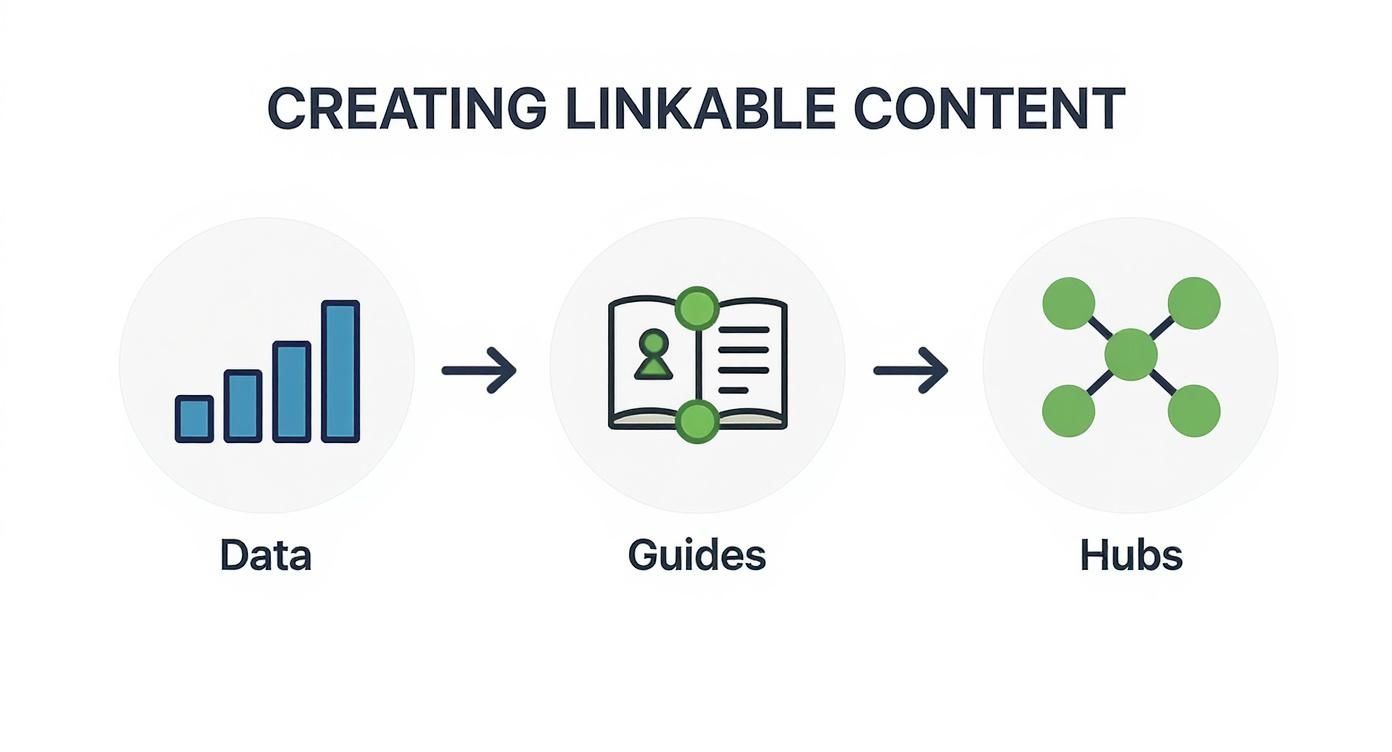
As you can see, the most powerful link-building content often starts with unique data, which is then shaped into comprehensive guides and resource hubs that become natural link magnets.
Building Your Prospect List
A curated prospect list is the foundation of a successful outreach campaign. Forget the "spray and pray" method. Your goal is to pinpoint websites and writers who have a genuine reason to care about your content.
Start by finding sites that have linked to similar content or your direct competitors. SEO tools can help with this. But don't stop there. Think about what your ideal customer reads.
- Niche Bloggers: Who serves your audience? If you sell sustainable home goods, find blogs about eco-friendly living.
- Industry Publications: Trade magazines and news sites covering your market provide authoritative links.
- Lifestyle Journalists: If you have a great gift guide or beautiful product, lifestyle writers are always looking for fresh ideas.
A hand-picked list of 50 highly relevant prospects will always outperform a generic list of 5,000. For ecommerce, quality crushes quantity every time.
Crafting the Perfect Pitch
Your outreach email is your one shot to make an impression. It must be personal, concise, and immediately show value. Generic, template-driven emails get deleted instantly.
The pitches that get responses follow a simple structure:
- The Personal Touch: Show you’ve done your research. Mention a recent article they wrote that connects to your pitch. This proves you're not a bot.
- The Value Prop: Get straight to the point. Explain what you’re offering and why it’s a perfect fit for their audience.
- The Clear Ask: Be direct. State whether you’re hoping for a link in an existing article or consideration for a new story.
Sometimes, you can find an older, relevant article that would be a perfect home for your link. Proposing this update, called a niche edit, can be very effective. To learn more, see our guide on how to acquire niche edit links.
The Unstoppable Rise of Digital PR
Digital PR has become a dominant link-building tactic for a reason: it works. Data for 2025 shows 48.6% of SEOs see it as their top strategy, and 89.6% of marketers agree it's the most effective way to build links. You can explore more detailed link building statistics to see how strong this trend is.
Digital PR shifts the focus from asking for links to earning media coverage. You pitch a newsworthy story, data point, or expert opinion that your content supports.
Different outreach methods have their pros and cons. Choosing the right one depends on your resources and goals.
Outreach Method Comparison for Ecommerce
This table breaks down common outreach tactics, showing the required effort versus the likely payoff.
| Outreach Method | Typical Link Quality | Required Effort | Scalability | Best For |
|---|---|---|---|---|
| Digital PR | Very High | High | Medium | Earning top-tier media placements and building brand authority. |
| Guest Blogging | Medium to High | High | Low | Building relationships and getting links from niche blogs. |
| Broken Link Building | Medium | Medium | Medium | Finding quick, targeted opportunities on resource pages. |
| Resource Page Links | Medium | Low | High | Gaining foundational links from relevant industry lists. |
By mastering digital PR and personalized outreach, you build a system for earning backlinks that truly move the needle. This is a core marketing function that builds your brand, drives traffic, and secures your search position for years.
Using Technical SEO to Amplify Your Link Building
Getting a great backlink is a huge win, but if your site's technical foundation is shaky, that authority can vanish. A clean technical setup ensures every link you build delivers its full value.
Many e-commerce platforms have SEO issues out of the box. They’re built for selling, not ranking. Messy filtered navigation or improper canonical tags can confuse search engines, splitting link authority across duplicate pages. Your hard-earned link value gets diluted.
Taming Common E-commerce Technical Glitches
One of the biggest culprits is faceted navigation—the filters for size, color, or brand. While great for users, it can generate thousands of unique URLs for the same page. Without proper setup, search engines see this as duplicate content, and links to those filtered URLs lose value.
The fix is using the canonical tag to tell search engines which page is the "master" version.
By adding a canonical tag to filtered pages that points back to the main category page, you funnel all link authority into one place. This simple line of code ensures a link to a "blue, size 10, leather shoes" page passes its full value to your primary "men's shoes" category page.
Another common issue is pagination, where a category spans multiple pages. If misconfigured, it can cause duplicate content issues or block link authority. Using rel="next" and rel="prev" tags helps search engines understand the sequence, allowing authority to flow correctly.
Multiplying Your Impact with Strategic Internal Linking
While external links are the prize, your internal linking strategy is the force multiplier. It directs authority from your link-worthy content to the pages that drive revenue. You must build these pathways yourself.
Imagine your popular blog post, "A Beginner's Guide to Choosing Hiking Boots," has earned many backlinks. That page is now an authority powerhouse. To leverage this, add contextual internal links from that guide directly to your top-selling hiking boot product pages.
This creates a powerful channel for link equity to flow.
- Blog Posts to Product Pages: In informational content, look for natural opportunities to link to specific products. Instead of a generic "shop our hiking boots" link, link the phrase "waterproof Gore-Tex boots" directly to that product.
- Resource Hubs to Category Pages: A massive resource like a "Complete Guide to Home Brewing" must contain prominent links to your main "Home Brewing Kits" and "Ingredients" category pages.
- Connecting Related Products: Sections like "You might also like" aren't just for upsells. They create a smart web of internal links, helping users and search engines discover more of your catalog.
When you are intentional with technical SEO and internal linking, you create a solid framework that makes your link building for ecommerce far more effective. It ensures no link authority is wasted and every backlink works as hard as possible to boost rankings and sales.
How to Measure Your Link Building ROI
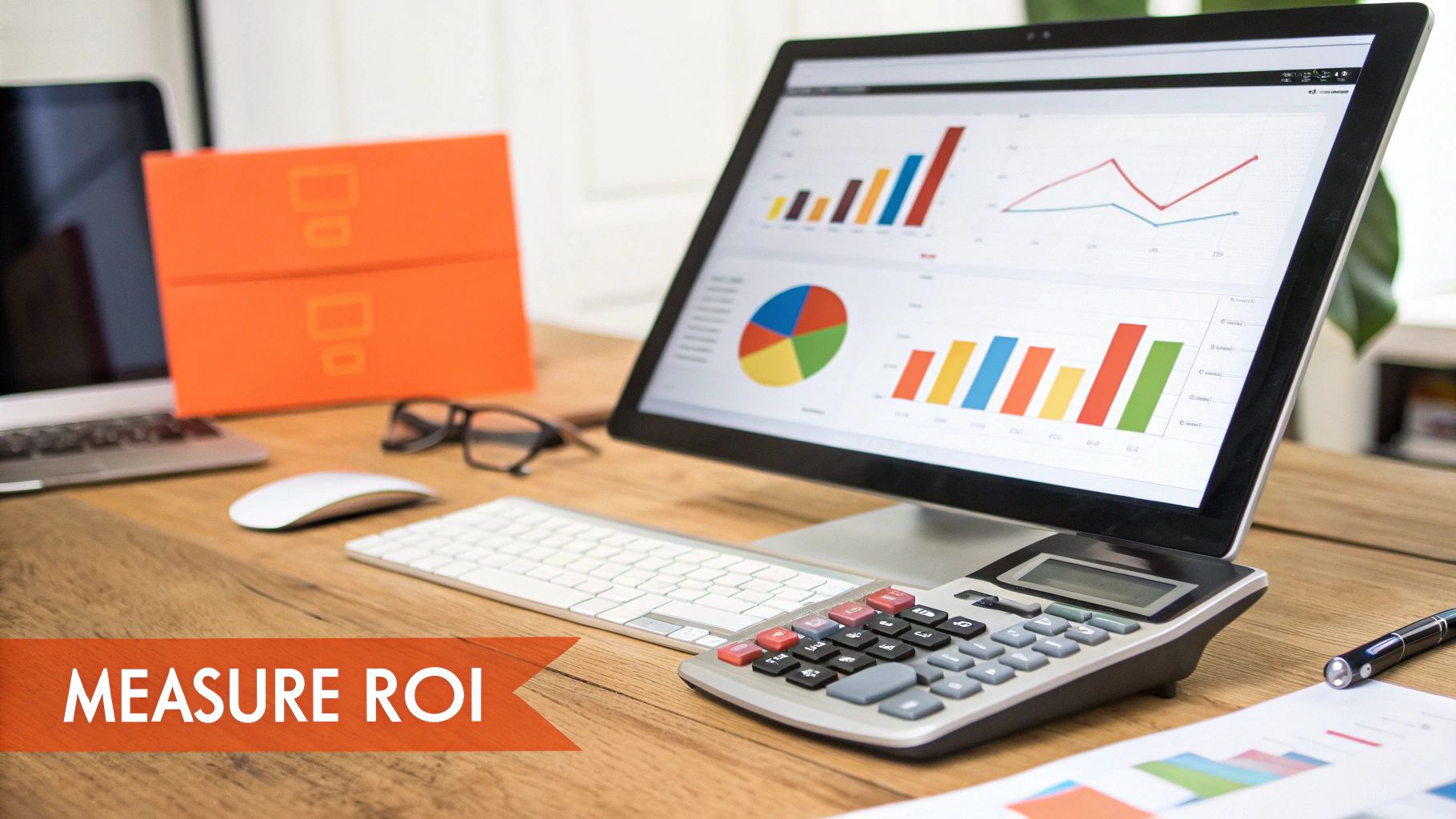
You've launched your campaign, but now you must prove its value. Securing future budget and knowing where to focus next depends on connecting new links to business growth.
Success in link building for ecommerce isn’t just about link counts. The real question is: how do those links translate to better search visibility, more traffic, and more sales? To answer that, you need to track the right key performance indicators (KPIs).
Key Metrics for Ecommerce Link Building
Focus on performance-driven data, not vanity metrics. Tracking the right KPIs will show how your backlink efforts contribute to revenue and justify your investment.
Here are the essential metrics to monitor:
-
Keyword Ranking Improvements: The most direct sign of success. Are your target keywords for high-value pages climbing in the search results? A steady upward trend is what you want.
-
Referral Traffic: Use Google Analytics to see how much traffic comes directly from your new links. This represents potential customers clicking through to your store.
-
Domain Authority (DA) Growth: While a third-party metric from tools like Moz, a rising Domain Authority score is a good indicator of growing site authority.
-
Conversion Rate from Referrals: This is the bottom line. Don't just look at traffic; see how many visitors from referring sites make a purchase. This metric draws a straight line from a backlink to a sale.
A healthy backlink profile is diverse and grows naturally over time. Watching these metrics tells you which tactics are driving real value, so you can double down on what works.
To learn more, it's helpful to understand what a backlink profile is and its key components.
Frequently Asked Questions
Even seasoned e-commerce pros have questions about link building. Here are answers to some of the most common ones.
How Can You Get Backlinks Directly to Product Pages?
It's tough, as most people don't link to purely commercial pages. The trick is to make your product page the best resource online for that specific item.
Go beyond a "buy now" button and generic description. Add real value with elements like:
- User-Generated Galleries: Showcase photos from real customers using your product for social proof and authentic content.
- Comprehensive Q&As: Answer every possible question someone could have about the product right on the page.
- Exclusive How-To Videos: Create a high-quality video showing the product solving a real problem.
When you do this, your product page becomes a definitive source of information—something genuinely worth linking to.
What’s a Realistic Link Building Budget for an Online Store?
There is no single answer. The budget depends on your market's competitiveness and your growth targets. A boutique store in a small niche can succeed with a modest budget, while a brand in a space like consumer electronics will need a significant investment.
The better question is, "What results do I need?" Work backward from your revenue goals to frame the investment. Analyze what top competitors are likely spending—you need to be in the same ballpark to compete.
How Long Does It Take to See Results From Link Building?
Link building is a marathon, not a sprint. It's about building authority over time. You should see some positive movement in keyword rankings within three to six months of consistent, high-quality effort.
However, for significant results that impact your bottom line—like major jumps in organic traffic and sales—you're typically looking at six to twelve months.
Patience is key. Every quality link is another brick in your brand's foundation, creating an asset that will pay dividends for years.
Ready to automate your link building and see faster results? BlazeHive uses AI to connect you with relevant backlink opportunities, saving you time and money. Start building powerful links today.

